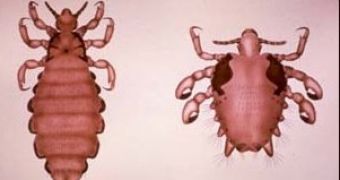Lice need their "forest" in order to survive. However, just like the Brazilian Amazon forests, another one seem to be lost forever, thanks to the influence of modern civilization... A British research published in the June 2006 issue of the Sexually Transmitted Infections journal revealed that crab rates in Leeds area declined first in women and several years after in men, in a context in which other STDs were stationary or increasing. It appears that the bikini wax treatment (also called "The Brazilian") has left crabs with no habitat.
"Although initially predominantly seen in females, extensive hair depilation, including pubic hair, has become popular in males in the past few years. This, along with reduced transmission rates from female partners, may account for the recent similar reduction in male patients," wrote the authors.
We are unique among primates for hosting two different kinds of lice: one on our heads and bodies (Pediculus) and pubic lice (Pthirus). By comparison, chimps have only head lice and gorillas only pubic lice. The pubic lice live in the pubic hairs and the result of their feeding on the blood of their hosts are irritating spots on the skin. Pubic lice can survive for up to 24 hours once removed from their host. Lice lack wings and cannot jump like fleas, so they remain bound to their host until they come into close contact with another individual; each species of pubic lice is specific to only one host species.
This recent study clearly revealed that crabs, or pubic lice, are on the verge of extinction, at least in the western world. In the Netherlands, even exemplars to be displayed in museums are hard to find. "When the bamboo forests that the Giant Panda lives in were cut down, the bear became threatened with extinction. Pubic lice can't live without pubic hair. We learned this lesson with the house sparrow. Twenty years ago we thought, 'why bother to get one?' since they're so common. Next thing you know, the sparrow was on the threatened species list and they're almost impossible to find in the Netherlands," Kees Moeliker, curator of the Rotterdam Natural History Museum, told the AP.
"We know they still exist, but it's very difficult to get an oversight on numbers. Crab lice can be treated with medicines similar to those used on head lice, and people who get crabs are often too embarrassed to tell their doctors," said Zant Kuijl of the Dutch Center for Sexually Transmitted Diseases.
The situation is the same in the U.S. "Unfortunately, we don't have any recent trend analysis data on pubic lice that would be helpful," a spokeswoman for the U.S. Centers for Disease Control told the AP.
Pubic lice origin
A 2007 DNA analysis showed that pubic lice were transferred from gorillas to early humans; however, it is more likely that they got the pubic lice from sleeping in abandoned gorilla nests or eating gorilla corpses than from having intercourse with these animals, as some theories suggested.
The DNA of the Pthirus gorillae lice from Ugandan gorillas was compared to that of the human crab, Pthirus pubis. Human-chimp branch split from the common ancestor with the gorillas about 7 million years ago. Still, the DNA analysis found the genes of Pthirus gorillae and Pthirus pubis diverged just 3.3 million years ago.

 14 DAY TRIAL //
14 DAY TRIAL //